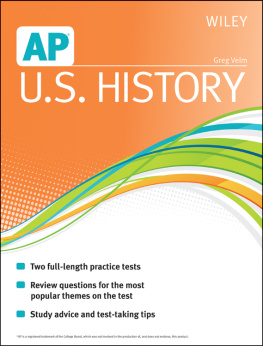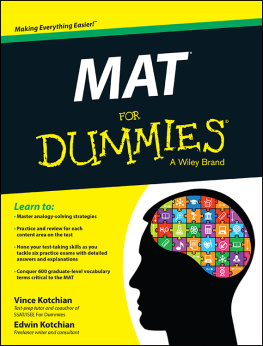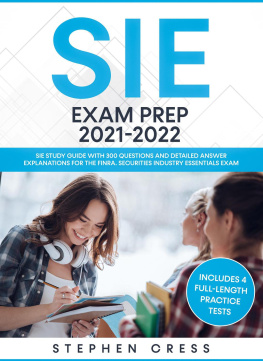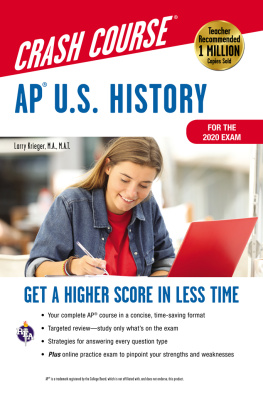

Wiley AP* U.S. History
Published by
John Wiley & Sons, Inc.
111 River St.
Hoboken, NJ 07030-5774
www.wiley.com
Copyright 2013 by John Wiley & Sons, Inc., Hoboken, New Jersey
No part of this publication may be reproduced, stored in a retrieval system or transmitted in any form or by any means, electronic, mechanical, photocopying, recording, scanning or otherwise, except as permitted under Sections 107 or 108 of the 1976 United States Copyright Act, without the prior written permission of the Publisher. Requests to the Publisher for permission should be addressed to the Permissions Department, John Wiley & Sons, Inc., 111 River Street, Hoboken, NJ 07030, (201) 748-6011, fax (201) 748-6008, or online at http://www.wiley.com/go/permissions .
Trademarks: Wiley and the Wiley logo are trademarks or registered trademarks of John Wiley & Sons, Inc. in the United States and other countries and may not be used without written permission. *AP is a registered trademark of the College Board, which was not involved in the production of, and does not endorse, this product. All other trademarks are the property of their respective owners. John Wiley & Sons, Inc., is not associated with any product or vendor mentioned in this book.
Limit of Liability/Disclaimer of Warranty : The publisher and the author make no representations or warranties with respect to the accuracy or completeness of the contents of this work and specifically disclaim all warranties, including without limitation warranties of fitness for a particular purpose. No warranty may be created or extended by sales or promotional materials. The advice and strategies contained herein may not be suitable for every situation. This work is sold with the understanding that the publisher is not engaged in rendering legal, accounting, or other professional services. If professional assistance is required, the services of a competent professional person should be sought. Neither the publisher nor the author shall be liable for damages arising herefrom. The fact that an organization or Website is referred to in this work as a citation and/or a potential source of further information does not mean that the author or the publisher endorses the information the organization or Website may provide or recommendations it may make. Further, readers should be aware that Internet Websites listed in this work may have changed or disappeared between when this work was written and when it is read.
For general information on our other products and services, please contact our Business Development Department in the U.S. at 317-572-3205.
Library of Congress Control Number: 2012952201
ISBN 978-1-118-49026-6 (pbk); ISBN 978-1-118-49027-3 (ebk); ISBN 978-1-118-49025-9 (ebk); ISBN 978-1-118-49029-7 (ebk)
Manufactured in the United States of America
10 9 8 7 6 5 4 3 2 1
Publishers Acknowledgments
Project Editor: Tracy L. Barr
Executive Editor: Lindsay Sandman Lefevere
Copy Editor: Megan Knoll
Technical Reviewer: Albert Lowey-Ball
Project Coordinator: Katie Crocker
Cover Photo: aleksandar velasevic / iStockphoto.com
About the Author
Greg Velm is the author of the best-selling book True Gold: History and Adventure in Northern California. Hes been in The New York Times, Time, Youth, and Via Magazine. Greg has lectured at Berkeley, the University of San Francisco, and the University of California, Davis, on social history. He lives with his family near the American River in California. When hes not living in the past, Greg rides mountain bikes through the Sierra foothills and tries to outsurvive other old dudes in the shortest triathlons he can find.
Authors Acknowledgments
Nobody ever writes a book by himself; I get by with a little help from my friends and fellow thinkers Bob Strickler, Mike Tucker, Patricia Rose, Albert Lowey-Ball, Bob Greeley, P. K. Agarwal, Rayne Dawson, Wayne Fiske, Terry Taylor, Mary Ann McDonnell, John Azzaro, Irick Collins, Bodhi Garrett, Jean Caspers, Stuart Bair, Craig Lovell, Dan Egerter, Rick Kraus, and Terry and Mo Burton. Thanks to the dedicated teachers who create beautiful history sites and to the thousands of anonymous contributors to the ever-expanding and improving world of Wikipedia. Thanks to Matt Wagner of Fresh Books and to my talented editors at Wiley: Tracy Barr and Lindsay Lefevere.

I
About the AP U.S. History Exam
An Introduction to the Exam and General Study Strategies

Important themes and topics in U.S. history
AP grading policies
How to discover the AP credit policies at your college of choice
Test day preparation
O f course, you want to pass the AP U.S. History exam. To do that, you need to know how the test is structured and what kind of information youre expected to know. After you understand how the test makers think, you can begin to prepare for success on test day. To set yourself up for success, you also have to get a clear understanding of what a good grade on the AP U.S. History exam looks like.
WHATS ON THE TEST
The AP U.S. History exam is a comprehensive ordeal composed of 80 multiple-choice questions and 3 essay questions. You have to face one big Document-Based Question (DBQ), where the College Board (CB) shows you a bunch of original documents and you formulate a thesis and support it, using these sources plus the knowledge you (hopefully) possess about the events behind the sources. The other two essay questions come in two groups of two questions each; you get to choose one question from each group to answer. Fifty percent of the exam score comes from the multiple-choice portion of the test; the other 50 percent comes from the essays.
If I knew exactly what questions would be on your AP U.S. History test, I would have to be one of the six teachers on the AP U.S. History Development Committee and even those teachers dont know until the last minute. But it is possible to look at past tests to see what subjects tend to come up again and again. It is possible to judge the trends by seeing the direction the big test is moving. You can also look at the announced subject material and time-period proportions to help choose which baskets to put most of your studying eggs in. In the following sections, you get a look at AP U.S. History teaching priorities as outlined by the very folks who make up the test. In , you learn how to study the way the Test Masters recommend. You even discover how to find previous tests to help you prepare for this years AP challenge.

Dont mess with AP test security. Forbidden actions include discussing multiple-choice questions from the exam with anybody even your AP teacher. You can talk about essay questions a day after the test (to make sure that test takers in all the time zones around the world are done writing). The CB doesnt let you talk about multiple-choice questions, ever, because it may use the questions again.
Advanced placement in the year 0
Standardized testing for advancement in China started with the Han Dynasty, around the year 0. And, like an ancient College Board, Chinese placement exams kept cranking out the grades for almost 2,000 years. Over the years, the tests included military strategy, civil law, revenue and taxation, agriculture and geography, and plenty of confusing Confucian religious classics. If you think the AP U.S. History test is hard, try taking it in Chinese characters!











